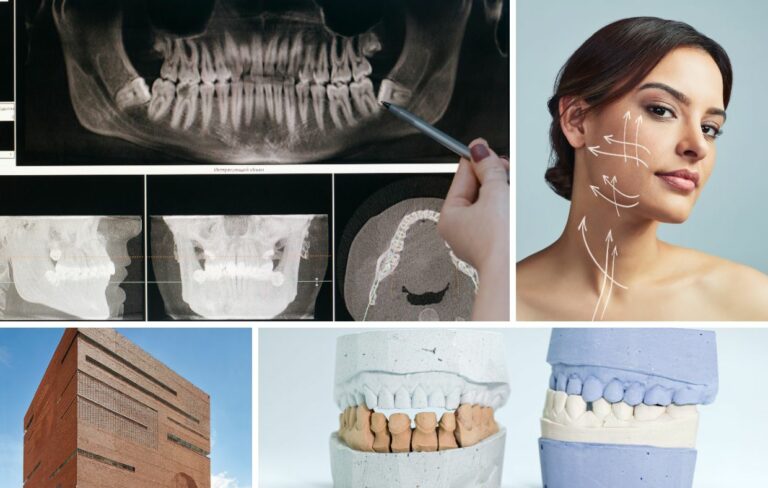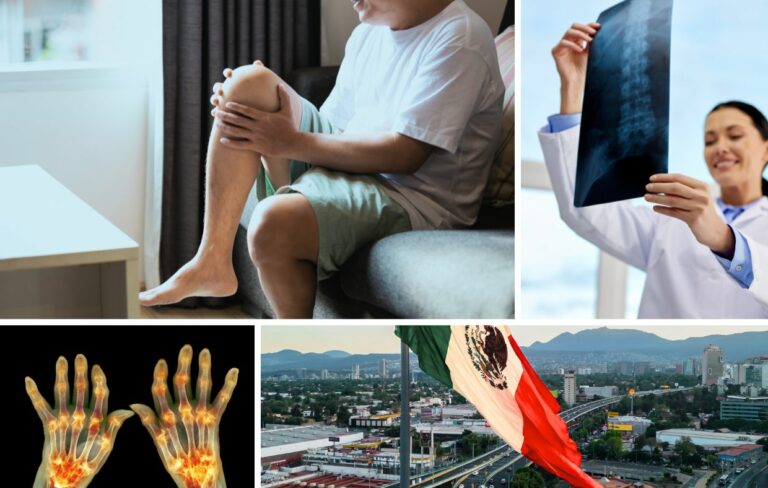Book Appointment Now
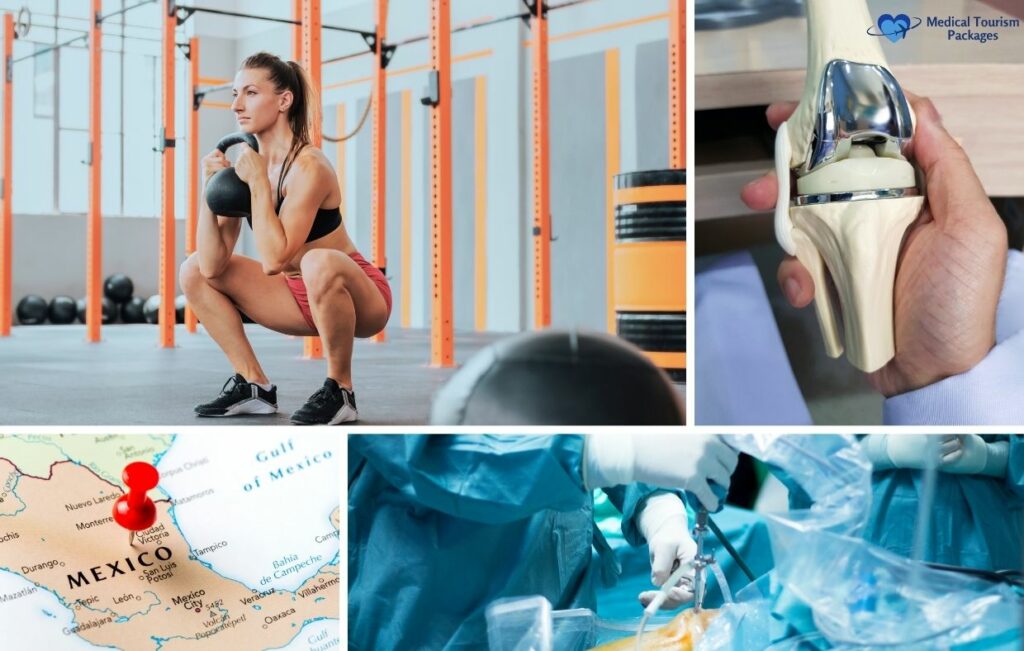
Knee Replacement Surgery in Mexico: Complete Guide, Costs, and Recovery
If you’re facing knee replacement surgery, you’ve likely encountered two major obstacles: high costs and long wait times. In the United States, total knee replacement can cost $30,000 to $50,000 or more, often leaving patients with substantial out-of-pocket expenses even with insurance. Canadian patients face a different challenge. Publicly funded healthcare means no direct costs, but wait times frequently stretch six months to over a year.
Mexico has emerged as a leading destination for knee replacement surgery, offering the same procedures at 60-70% lower costs while maintaining international quality standards. Board-certified orthopedic surgeons, many trained in the US or Europe, perform thousands of successful knee replacements each year in JCI-accredited facilities located in cities like Tijuana, Cancun, and Guadalajara. Learn more about medical tourism in Mexico and why it has become a trusted choice for international patients.
This guide covers everything you need to know about getting knee replacement surgery in Mexico. You’ll learn about actual costs, how to select qualified surgeons and accredited hospitals, what to expect during your recovery timeline, and how to plan your medical trip. We’ll also address safety considerations, insurance options, and post-operative care to help you make an informed decision about whether medical tourism is right for your knee replacement needs.
What is Knee Replacement Surgery?
Knee replacement surgery, medically known as knee arthroplasty, is an orthopedic procedure that removes damaged portions of your knee joint and replaces them with artificial components. The surgeon removes deteriorated bone and cartilage from your thighbone (femur), shinbone (tibia), and kneecap (patella). These surfaces are then replaced with metal and high-grade plastic prosthetic parts designed to replicate natural knee movement.
This surgery is typically recommended for patients with severe knee arthritis, particularly osteoarthritis, rheumatoid arthritis, or post-traumatic arthritis. You may be a candidate if you experience chronic knee pain that limits daily activities like walking, climbing stairs, or getting up from a chair. Most patients pursue knee replacement only after conservative treatments have failed. These include physical therapy, weight management, pain medications, cortisone injections, and other non-surgical interventions.
The primary goal of knee replacement is to eliminate or significantly reduce chronic pain that has diminished your quality of life. Beyond pain relief, the procedure aims to restore mobility and function so you can return to normal daily activities. Most patients experience dramatic improvements in their ability to walk, exercise moderately, and perform routine tasks without discomfort. While knee replacement won’t allow you to run marathons or play high-impact sports, it should restore your independence and active lifestyle within the normal range of daily activities.
Why Consider Mexico for Knee Replacement Surgery?
Mexico has become one of the top destinations worldwide for knee replacement surgery, attracting thousands of medical tourists annually from the United States and Canada. The country offers a compelling combination of quality healthcare infrastructure, significant cost savings, and geographic convenience. Mexican hospitals specializing in orthopedic procedures have invested heavily in modern equipment and international accreditation to meet the standards expected by international patients.
The appeal goes beyond just lower prices. Mexico’s proximity to the US and Canada means shorter travel times and minimal jet lag compared to destinations in Asia or Europe. Many border cities like Tijuana are just hours from major US metropolitan areas. Additionally, the growing medical tourism industry has created comprehensive support systems for international patients, including English-speaking staff, patient coordinators, and streamlined processes for medical travelers.
Mexican orthopedic surgeons often receive training at prestigious institutions in the United States, Europe, and Canada before returning to practice in their home country. They use the same surgical techniques, prosthetic implants from leading manufacturers like Zimmer, Stryker, and DePuy, and evidence-based protocols found in North American hospitals. This combination of international expertise, modern facilities, and substantial cost savings makes Mexico an increasingly attractive option for patients seeking knee replacement surgery.
High-Quality, JCI-Accredited Medical Facilities
Joint Commission International (JCI) accreditation represents the gold standard in global healthcare quality. This US-based organization evaluates hospitals on patient safety, infection control, medication management, and clinical outcomes using the same rigorous criteria applied to American hospitals. When a Mexican facility earns JCI accreditation, it demonstrates compliance with international best practices and commitment to continuous quality improvement.
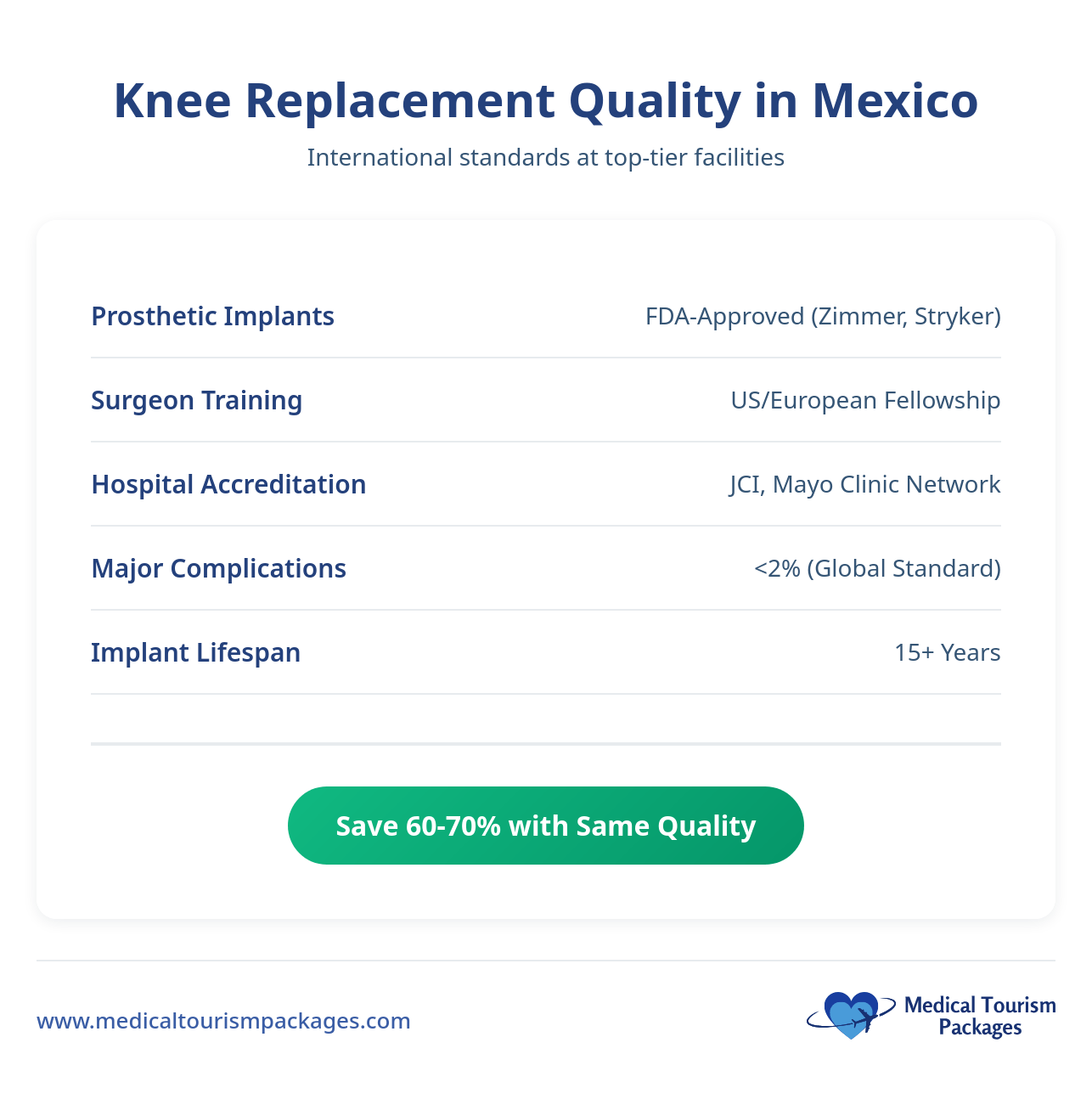
JCI-Accredited Facilities:
- Hospital Ángeles Tijuana – Full-service hospital with dedicated orthopedic department and state-of-the-art surgical suites
- Galenia Hospital (Cancun) – Holds both JCI accreditation and ACI Qmentum International certification, indicating dual international quality recognition
- Hospital Star Médica – Multi-location network with specialized orthopedic centers throughout Mexico
- Médica Sur (Mexico City) – Premier academic medical center with advanced orthopedic and rehabilitation services
Other Accredited Facilities:
- Hospital de Especialidades del IMSS (Guadalajara) – ISO 9001 certified for quality management systems in healthcare delivery
These hospitals specialize in advanced orthopedic procedures including total and partial knee replacement. They are strategically located in major cities including Tijuana, Cancun, Guadalajara, Mexico City, and Monterrey, providing options across different regions of Mexico. Each facility maintains dedicated orthopedic departments with specialized equipment, modern operating rooms, and post-surgical rehabilitation services specifically designed for joint replacement patients.
Cost-Effective Compared to the US and Canada
The cost savings for knee replacement surgery in Mexico are substantial, with patients typically paying 60-70% less than comparable procedures in the United States or Canada.
| Expense Category | Mexico (USD) | United States (USD) | Canada (USD) |
|---|---|---|---|
| Surgery Cost | $10,000-$18,000 | $35,000-$70,000 | $18,000-$33,000 |
| Hospital Stay (3-5 days) | Included in package | $5,000-$10,000 | High |
| Medication | Included | $1,000-$2,000 | Variable |
| Physical Therapy | $2,500-$7,000 extended | $75-$200 per session | High |
| Total Estimated Cost | $10,000-$25,000 | $40,000-$80,000+ | $25,000-$45,000 |
The cost comparison reveals substantial savings of 60-70% when choosing Mexico for knee replacement surgery. Even when factoring in travel expenses, accommodations for a companion, and extended recovery time in Mexico, most patients save tens of thousands of dollars compared to paying out-of-pocket in the United States. For Canadian patients, while the surgery itself may be covered by provincial health insurance, private procedures in Mexico eliminate lengthy wait times and often include services like private rooms and comprehensive physical therapy that may not be fully covered at home. These figures clearly demonstrate the affordability advantage that makes Mexico an attractive option for knee replacement surgery.
Preparing for Knee Replacement Surgery in Mexico
Proper preparation is essential for a smooth medical tourism experience and successful recovery. Taking time to research your options, verify credentials, and understand all associated costs will help you make informed decisions and avoid unexpected complications. The preparation phase also allows you to arrange necessary travel documents, coordinate with your chosen facility, and set up support systems both in Mexico and back home. Patients who invest effort in thorough preparation report higher satisfaction levels and better overall outcomes from their knee replacement surgery abroad.
Researching and Choosing Accredited Hospitals
Always choose hospitals that hold accreditation from recognized international organizations such as Joint Commission International (JCI), Accreditation Canada International (ACI), or ISO certification. These accreditations ensure the facility meets the highest standards of healthcare quality, patient safety, and clinical excellence. Accredited hospitals undergo regular audits and must demonstrate compliance with strict protocols for infection control, surgical procedures, and post-operative care.
Focus your search on established medical tourism hubs that have developed robust infrastructure for international patients. Tijuana offers easy access for US patients, particularly those from California and the Southwest. Cancun combines medical services with resort amenities for patients who want to include recovery time in a vacation setting. Guadalajara is known for its medical excellence and lower costs compared to border cities. Puerto Vallarta provides a coastal recovery environment with quality facilities. Mexico City houses some of the country’s most prestigious academic medical centers with cutting-edge technology. These cities have proven track records serving international patients and offer comprehensive support services in English.
Selecting a Surgeon with a Strong Track Record
Choosing the right surgeon is one of the most critical decisions you’ll make, and thorough credential verification helps ensure you receive the highest quality care.
Tips for verifying surgeon credentials:
- Verify US or European fellowship training in joint reconstruction – Look for surgeons who completed advanced training at recognized institutions in orthopedic surgery and specifically in joint replacement procedures
- Confirm minimum 15 years specialized experience – Experienced surgeons have performed thousands of procedures and encountered diverse cases that build expertise
- Check online reviews and patient testimonials – Read experiences from previous international patients on medical tourism platforms and review sites
- Request success rate data and complication rates – Ask directly about surgical outcomes, infection rates, and revision surgery percentages
- Ask about annual procedure volume – Surgeons performing at least 50-100 knee replacements yearly maintain sharp skills and stay current with techniques
- Use telemedicine consultations to meet surgeon before traveling – Video consultations allow you to assess communication, ask questions, and evaluate your comfort level with the surgeon
Understanding the Full Costs, Including Hidden Fees
Understanding the complete financial picture before committing to surgery prevents unwelcome surprises and allows accurate budget planning. Many hospitals offer all-inclusive packages, but it’s important to clarify exactly what is and isn’t included in the quoted price.
Table: Potential Costs Breakdown
| Cost Category | Description | Estimated Range (USD) |
|---|---|---|
| Surgical Procedure | Surgeon’s fees, anesthesia, operating room | $10,000 – $18,000 |
| Hospital Stay | 3-5 nights including nursing care and meals | Included in package |
| Medication | Post-surgery prescriptions | Included in package |
| Physical Therapy | Initial PT sessions | Included (some packages: 5 sessions) |
| Extended PT | Long-term rehabilitation | $2,500 – $7,000 |
| Recovery Stay | Mandatory 10-14 day accommodation | $500 – $1,500 |
| Hidden Fees | Follow-up consultations, imaging | Variable |
Always request a detailed, itemized quote that breaks down all anticipated costs before making your final decision. This should include surgical fees, hospital charges, medications, initial physical therapy, and any mandatory recovery accommodation. Ask specifically about additional charges for complications, extended hospital stays, or follow-up imaging. Understanding the full financial implications helps you budget appropriately and compare offers accurately between different facilities. Medical financing options are available for qualified patients with credit scores of 640 or higher, typically offering 2-5 year repayment terms to make the procedure more accessible.
The Knee Replacement Surgery Process in Mexico
The knee replacement process in Mexico follows a carefully structured protocol designed to maximize safety and optimize outcomes. From initial assessments through surgery and early recovery, each phase has specific purposes and timelines. Mexican orthopedic centers have refined their procedures based on international best practices and years of experience treating medical tourism patients. Understanding what happens at each stage helps you prepare mentally and physically for the journey ahead.
Pre-Surgery Assessments and Lab Tests
Before your surgery can proceed, you’ll undergo a comprehensive series of medical evaluations to ensure you’re healthy enough for the procedure and to identify any potential risks.
| Assessment/Test Type | Description | Purpose |
|---|---|---|
| Blood Tests | Check for anemia, infection, clotting function | Ensure fitness for surgery |
| Medical History | Review of conditions, medications | Identify potential risks |
| Cardiac Evaluation | EKG based on patient history | Assess heart ability for anesthesia |
| Imaging | X-rays, possibly MRI | Plan surgical approach |
| Physical Exam | Knee range of motion assessment | Guide rehabilitation planning |
You should plan to arrive in Mexico 2-3 days before your scheduled surgery date to complete these essential pre-operative assessments. This timeline allows the medical team to review all test results, address any concerns, and make final preparations for your procedure. The pre-surgery period also gives you time to acclimate to your surroundings, meet your surgical team, and ask any last-minute questions before the operation.
The Surgery Procedure: Techniques and Technology Used
Mexican orthopedic centers utilize the latest surgical technologies and techniques to ensure precision, reduce complications, and speed up your recovery.
| Technique/Technology | Description | Benefits |
|---|---|---|
| Minimally Invasive Surgery | Smaller incisions, less tissue disruption | Reduces pain, speeds recovery |
| Computer-Assisted Surgery (CAS) | Computer guidance for precision | Improves implant placement accuracy |
| Robotic-Assisted Surgery | Robotic arms assist surgeon | Increases accuracy, reduces complications |
| 3D Imaging | Pre-operative planning with detailed visualization | Enhanced surgical precision |
The actual knee replacement surgery typically takes 1.5 to 2 hours to complete. Mexican orthopedic surgeons use FDA-approved knee implants from the same manufacturers found in US hospitals, including industry leaders like Zimmer and Stryker. This means you receive identical prosthetic components to those used in American facilities. You will receive either spinal anesthesia, which numbs you from the waist down while you remain conscious, or general anesthesia, which puts you completely to sleep during the procedure. Your surgeon and anesthesiologist will recommend the best option based on your medical history and personal preferences.
Post-Surgery Recovery: Hospital Stay and Initial Recovery
Your recovery after knee replacement follows a carefully monitored timeline, with each phase designed to maximize healing while minimizing complications.
| Recovery Phase | Description | Duration |
|---|---|---|
| Immediate Post-Op | Recovery room monitoring, pain management, start mobility | 24-48 hours |
| Hospital Stay | Continued care, wound monitoring, supervised PT | 3-5 days average |
| Mandatory Mexico Stay | Before air travel clearance (DVT/PE prevention) | 10-14 days NON-NEGOTIABLE |
| Early Rehabilitation | Physical therapy to improve range and strength | Starts in hospital, continues weeks-months |
CRITICAL SAFETY REQUIREMENT: The 10-14 day mandatory stay in Mexico before air travel is non-negotiable and potentially life-saving. After knee replacement surgery, you face significantly elevated risk for deep vein thrombosis (DVT), which are blood clots that form in leg veins, and pulmonary embolism (PE), which occurs when these clots travel to your lungs. Air travel further increases clot formation risk due to prolonged immobility, cabin pressure changes, and dehydration. Flying too soon after surgery can result in fatal pulmonary embolism. Your surgeon must personally clear you for air travel after confirming your blood is properly anticoagulated, your mobility has improved sufficiently, and your surgical site shows proper healing. Attempting to fly earlier against medical advice puts your life at serious risk. Insurance companies and medical facilities enforce this requirement strictly because early travel complications can be fatal.
What Cities in Mexico are Best for Knee Replacement Surgery?
Different cities across Mexico offer distinct advantages for knee replacement surgery, from border convenience to resort-style recovery environments.
| City | Cost Range | Key Facilities | Primary Advantages |
|---|---|---|---|
| Tijuana | Competitive | Hospital Ángeles (JCI) | US border proximity, California access |
| Cancun | Market rate | Galenia (JCI, ACI) | Resort recovery, international airport |
| Guadalajara | Market rate | Hospital de Especialidades (ISO 9001) | Medical excellence hub |
| Puerto Vallarta | $9,500-$13,500 | Multiple facilities | Beach resort setting |
| Mexico City | Market rate | Star Médica, Médica Sur (JCI) | Most specialists, advanced technology |
Aftercare and Rehabilitation in Mexico
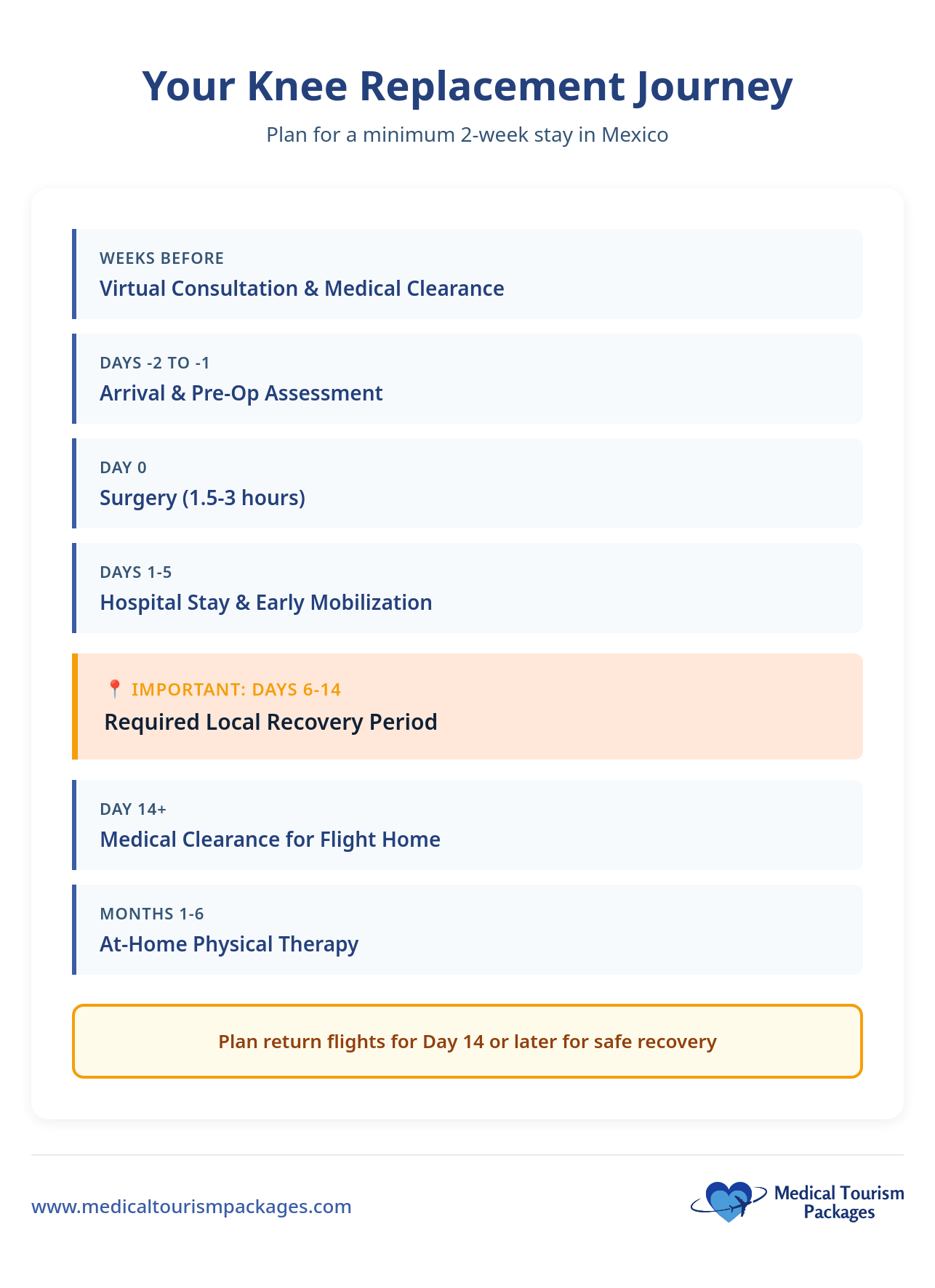
Aftercare and rehabilitation play essential roles in determining the success of your knee replacement surgery. The quality of physical therapy and follow-up care directly impacts your recovery speed, range of motion, strength restoration, and long-term satisfaction with your new knee. Mexican facilities recognize that comprehensive rehabilitation is just as important as the surgery itself. Many hospitals include structured aftercare programs specifically designed for international patients who need intensive therapy before returning home.
Physical Therapy Options: In-Hospital and Outpatient
Physical therapy is available at different stages of your recovery, with specialized services designed for both immediate post-operative care and long-term rehabilitation.
| Facility Type | Services Offered | Specialization |
|---|---|---|
| In-Hospital | Acute care PT, post-op mobilization, pain management | Early-stage recovery right after surgery |
| Outpatient Clinics | Advanced PT, custom exercise programs, extended rehabilitation | Long-term recovery and strengthening |
Most surgical packages include initial physical therapy sessions, typically covering your first five sessions during the hospital stay and early recovery period. These sessions focus on reducing swelling, restoring basic mobility, and teaching you essential exercises you’ll continue independently. Extended physical therapy beyond the included sessions costs an additional $2,500 to $7,000 depending on the duration and intensity of treatment. The minimum recommended physical therapy duration is 4-8 weeks, though some patients benefit from continued therapy for 3-4 months to achieve optimal strength and function. Starting therapy immediately and maintaining consistency throughout recovery significantly improves your final outcome.
Follow-Up Care with Your Surgeon: Schedule and Expectations
Regular follow-up appointments with your surgeon are essential for monitoring your healing progress and ensuring optimal long-term outcomes.
| Timeframe | Appointment Focus | Expectations |
|---|---|---|
| During 10-14 day stay | Daily monitoring, wound inspection, mobility progress | Assess healing, manage pain, DVT prevention |
| Before travel | Final clearance evaluation | Surgeon approval required for air travel |
| 6 Weeks Post-Op | Virtual or in-person follow-up | Progress evaluation, rehabilitation adjustment |
| 3, 6, 12 Months Post-Op | Long-term monitoring | Ensure continued recovery, address concerns |
Telemedicine follow-up appointments are available after you return home, allowing your Mexican surgeon to monitor your progress remotely through video consultations and review of imaging or photos you provide. Most surgeons maintain regular contact during the critical first several weeks after you leave Mexico to address any concerns and adjust your rehabilitation plan as needed. Before traveling to Mexico for surgery, it’s important to arrange local follow-up care with a physician and physical therapist in your home area who can provide in-person monitoring and hands-on therapy. Having this continuity of care established in advance ensures smooth coordination between your Mexican surgical team and your local healthcare providers.
Risks and Important Considerations for Surgery
While knee replacement surgery in Mexico offers significant benefits including cost savings and quality care, it’s important to understand the potential risks involved with any major surgical procedure. Being informed about possible complications and how they’re managed allows you to make educated decisions and recognize warning signs during recovery. Reputable Mexican facilities prioritize patient safety through rigorous protocols, but no surgery is entirely without risk.
Possible Risks and How They’re Managed
Like any major surgery, knee replacement carries certain risks, though reputable Mexican facilities implement strict protocols to minimize complications.
| Risk | What It Means | How It’s Prevented/Managed |
|---|---|---|
| Infection | Post-surgery infection (rare) | Strict sterilization, antibiotics, monitoring |
| Blood Clots (DVT/PE) | Can form but usually prevented | Early movement, anticoagulants, compression stockings, mandatory 10-14 day stay |
| Implant Issues | Rare loosening or wear over time | High-quality FDA-approved materials, precise surgical techniques |
| Persistent Pain/Stiffness | Limited range of motion | Comprehensive physical therapy, pain management |
Serious complications occur in fewer than 2% of patients at reputable facilities. JCI-accredited hospitals maintain international safety standards that match or exceed those found in US and Canadian facilities. These standards include stringent infection control protocols, evidence-based surgical techniques, and comprehensive post-operative monitoring systems designed to catch and address any issues early.
Managing Expectations: Realistic Outcomes and Recovery Time
Understanding what to realistically expect from your knee replacement surgery helps you set appropriate goals and stay motivated throughout the recovery process.
What to expect:
Most patients, approximately 90%, experience significant pain relief and improved function following knee replacement surgery. However, recovery is gradual and requires dedication to physical therapy and rehabilitation exercises. Your commitment to following post-operative instructions directly influences your final outcome. Some patients expect immediate results, but rebuilding strength and range of motion takes time and consistent effort.
Recovery Timeline:
- Walk with assistance: 24 hours post-op
- Walk independently or with cane: 3 weeks
- Light daily activities: 3-6 weeks
- Normal daily activities: 6-12 weeks
- Low-impact activities (golf, cycling): 12 weeks
- Full recovery: 6 months to 1 year
- Implant longevity: 15+ years
These timelines represent typical recovery patterns, though individual experiences vary based on age, overall health, pre-surgery condition, and adherence to rehabilitation protocols. Younger, more active patients often progress faster, while those with other health conditions may need additional time. Modern knee implants are designed to last 15 years or longer, with many patients experiencing 20-25 years of function before any revision surgery becomes necessary.
Returning Home After Surgery
Planning your safe return home is just as important as preparing for surgery. The journey back requires careful coordination with your medical team, appropriate travel arrangements, and established follow-up care in your home country. Rushing this process or inadequately preparing for the transition can compromise your recovery and potentially create serious health risks. Taking time to plan ensures continuity of care and peace of mind during this critical recovery phase.
Planning Your Travel: Timing and Assistance
Successfully returning home requires careful planning around your recovery timeline and arranging appropriate support for the journey.
Timing Your Travel:
- Work with your medical team to determine the safe travel date based on your individual recovery progress
- Minimum 10-14 days in Mexico before air travel is non-negotiable for your safety
- Surgeon clearance is required and must be documented before booking return flights
Arranging Travel Assistance:
- Request airport wheelchair services at both departure and arrival airports to minimize walking and standing
- Travel with a companion who can handle luggage and provide physical support throughout the journey
- Book comfortable seating arrangements, preferably aisle seats with extra legroom for easier movement
- Wear compression stockings during the entire flight to reduce blood clot risk
- Continue taking anticoagulant medications exactly as prescribed before and during travel
- Stay well hydrated throughout the flight and perform regular ankle pumps and leg exercises every 30-60 minutes
Post-Surgery Follow-Up Care: Coordinating with Local Doctors
Establishing a coordinated care plan between your Mexican surgical team and local healthcare providers ensures seamless monitoring throughout your recovery.
Before traveling to Mexico:
- Arrange for a local physician willing to provide post-operative care and monitor your recovery
- Confirm availability of a local physical therapist for continued rehabilitation sessions
- Ensure both providers accept continuity of care from international surgery and are willing to coordinate with your Mexican surgical team
After returning home:
- Schedule follow-up appointments promptly, ideally within the first week of returning
- Share complete surgical records, operative reports, and rehabilitation protocols with your local care team
- Address any concerns quickly, including unusual pain, swelling, or signs of infection
- Maintain regular communication with your Mexican surgeon via telemedicine for ongoing guidance
Warning signs requiring immediate medical attention:
- Signs of infection including fever above 101°F (38.3°C), increasing redness around incision, warmth, or drainage
- Severe uncontrolled pain that doesn’t respond to prescribed pain medication
- DVT symptoms such as sudden leg swelling, calf tenderness, chest pain, or shortness of breath, which require emergency care
Ready to Take the Next Step?
Getting knee replacement surgery in Mexico can be life-changing, but navigating the process alone can feel overwhelming. Whether you have questions about specific surgeons, need help comparing facilities, or want guidance on planning your medical trip, we’re here to help you every step of the way.
Contact us today to connect with experienced medical tourism coordinators who can answer your questions, provide personalized recommendations, and help you plan a safe, successful knee replacement journey. Your path to pain-free mobility starts with a simple conversation—let’s talk about your options.
Frequently Asked Questions About Knee Replacement in Mexico
Is knee replacement surgery in Mexico as safe as in the US or Canada?
Yes, when you choose JCI-accredited facilities with board-certified surgeons. These hospitals meet the same rigorous international safety standards as US and Canadian facilities. They use identical FDA-approved implants from manufacturers like Zimmer and Stryker, follow the same surgical protocols, and maintain strict infection control measures. Complication rates at top Mexican facilities are comparable to those in North America, typically under 2%.
Will my insurance cover knee replacement surgery in Mexico?
Most US and Canadian insurance plans do not cover elective procedures performed outside your home country. However, some plans do offer international coverage, and an increasing number of employers are adding medical tourism options to their benefits packages. It’s essential to contact your insurance provider directly to understand your specific coverage. Even without insurance coverage, the significant cost savings often make the procedure more affordable than meeting high deductibles at home.
How do I verify my surgeon’s credentials and experience?
Request documentation of your surgeon’s board certification, fellowship training locations, and years of specialized experience in knee replacement procedures. Ask for their annual procedure volume (look for 50-100+ knee replacements yearly) and complication rates. Most reputable surgeons readily provide this information and welcome video consultations where you can ask questions directly. You can also check reviews from previous international patients on medical tourism platforms and verify their hospital privileges at JCI-accredited facilities.
Can I bring a family member or friend with me?
Absolutely, and it’s highly recommended. Having a companion provides emotional support, helps with daily tasks during early recovery, and assists with travel logistics. Most hospitals and recovery facilities can accommodate companions in your room or nearby. Your companion will be especially valuable during the mandatory 10-14 day recovery period before you’re cleared for air travel. Many patients turn their medical trip into a bonding experience with their support person.
What happens if I have complications after returning home?
Before leaving Mexico, you’ll receive complete surgical records, rehabilitation protocols, and direct contact information for your surgical team. Your Mexican surgeon remains available via telemedicine for consultations and guidance. It’s crucial to arrange local follow-up care before traveling, ensuring you have a physician and physical therapist who accept continuity of care from international surgery. Most complications, if they occur, can be managed by local healthcare providers in coordination with your Mexican surgeon. For serious emergencies, seek immediate local medical attention.
Do doctors and hospital staff speak English?
Yes, hospitals that specialize in medical tourism employ English-speaking staff throughout their facilities, including surgeons, nurses, patient coordinators, and administrative personnel. Many surgeons completed training in the US or other English-speaking countries and are fluent in English. You’ll typically be assigned a patient coordinator who speaks English and serves as your main point of contact throughout your stay. Language barriers are rarely an issue at established medical tourism facilities.
How soon after surgery can I fly home?
You must wait a minimum of 10-14 days before air travel, and you cannot fly until your surgeon provides written clearance. This waiting period is non-negotiable and potentially life-saving. Flying too soon after knee replacement surgery significantly increases your risk of deep vein thrombosis (DVT) and pulmonary embolism (PE), which can be fatal. Your surgeon will evaluate your healing progress, mobility improvement, and anticoagulation status before approving travel. Plan for this mandatory recovery period when budgeting time and accommodations.
What’s included in the surgery package price?
Most all-inclusive packages cover the surgeon’s fees, anesthesiologist fees, operating room costs, hospital stay (typically 3-5 days), medications, initial physical therapy sessions (often 5 sessions), and post-operative follow-up appointments during your stay. However, packages vary by facility, so always request a detailed, itemized quote. Additional costs typically include extended physical therapy, recovery accommodations beyond the hospital stay, travel expenses, companion accommodations, and any complications requiring extended care. Clarify exactly what’s included before committing to avoid unexpected expenses.

